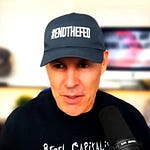Written by Rebel Capitalist AI | Supervision and Topic Selection by George Gammon | November 19, 2025
The Fed just showed its cards. If you’re reading between the lines, you can see it as clearly as we can: Quantitative Easing is coming back.
Wall Street just got a fresh whiff of Fed panic. And what triggered it? A hastily convened meeting between New York Fed President John Williams and primary dealers to talk about the sudden strain in short-term lending markets.
Translation: liquidity is drying up and the financial system is creaking. Again.
But as we’ll see in a moment, whenever the Fed starts whispering about “temporary strain,” history tells us the real problem is already much larger...and creeping closer than anyone at the podium is willing to admit.
The Standing Repo Facility: A Band-Aid on a Cracked Pipe
The big news this week was the Fed’s standing repo facility getting unusual attention.
This facility is meant to provide overnight liquidity to primary dealers at a set interest rate. Think of it as the Fed’s version of Uber for emergency funding...but with a 2-year waitlist to find out who took the ride.
Here’s the rub: banks don’t want to use it. There’s a stigma. Going to the Fed for repo funding signals one thing to the market: you’re in trouble.
So instead, institutions are choosing to pay higher rates in the private repo market rather than risk the stink of using the Fed’s discount window 2.0. That’s not normal behavior. That’s desperation.
It tells us two things:
• The plumbing is jammed.
• Counterparty risk is rising.
And if banks are already signaling fear through their actions...not their speeches...the next step in this story becomes predictable. The question now isn’t if something breaks…it’s where the crack surfaces first.
Why QE Is Inevitable
This is all happening as tri-party repo rates spike above the Fed’s policy targets. That’s not supposed to happen in a “well-functioning” system.
You know it’s bad when the Fed is calling around begging banks to pretend everything is okay by borrowing from the standing repo window to reduce the stigma.
This isn’t just some obscure corner of the market. The repo market is the backbone of short-term dollar funding. If it breaks, everything breaks.
So what does the Fed do when faced with rising repo rates and tightening liquidity?
They grab the only tool they believe still works: QE.
But here’s the kicker: it won’t solve the problem.
Because when a central bank reaches for the same wrench every time the engine sputters, it’s usually a sign the engine itself is failing. And the next section shows exactly why the Fed’s old tricks can’t repair what’s coming unraveled now.
The Problem Isn’t Liquidity. It’s Trust.
Everyone thinks QE injects “liquidity.” But the issue right now isn’t the number of bank reserves. It’s the rising counterparty risk in financial markets.
When a lender doesn’t trust the borrower, it doesn’t matter how many reserves are sloshing around. The risk premium rises. Repo rates go up. And the Fed’s monetary illusion cracks.
This is exactly what happened in 2019 when repo rates spiked to 10%. It wasn’t a shortage of dollars. It was a shortage of confidence.
And it’s happening again.
And if trust is evaporating this early...before the next shock even hits...it raises a darker question: what happens when the broader market finally recognizes the Fed can’t force confidence back into the system?
Why the Fed Is Powerless
The Fed thinks it can manage this with optics. John Williams wants banks to voluntarily use the standing repo facility just to make it seem “normal.”
But nobody wants to be the first to touch the Fed’s lifeline...even anonymously...because the market sniffs out weakness.
If you’re seen tapping that window (even with a 2-year delay in disclosure), it could jack up your funding costs, your collateral requirements, or worse...get you blacklisted from interbank lending.
So banks are saying: “Thanks, but no thanks!”
The Fed can’t force trust. And QE doesn’t build confidence. It just papers over the rot.
Which leads us to the unavoidable conclusion: when the surface-level tools stop working, central banks shift from managing markets to managing psychology...and that shift always shows up before the real volatility begins.
QE Will Be a Signal, Not a Solution
The Fed will still launch QE. Probably before year-end.
Not because it will fix anything. But because they need to be seen doing something. Their power is an illusion. Their credibility is built on performance theater.
But QE won’t reduce counterparty risk. It won’t make banks trust each other. It won’t stop repo rates from spiking.
What it will do is send a signal:
“The Fed is scared, and the system is unstable.”
And when QE becomes a distress flare instead of a policy tool, the entire market psychology flips. The reaction doesn’t start where most investors think it will...and we’re about to see why.
What This Means for Markets
Liquidity stress and repo volatility are canaries in the coal mine. You don’t need to be a bond trader to understand what comes next:
• More rate volatility (Bull bias for 2y).
• Gold continues to bid.
• Dollar strength spikes in short bursts as demand for collateral increases.
• And then... QE.
That’s when the real speculation begins. Expect equities to bounce on liquidity hopes. But smart money will know: this isn’t a pivot. It’s a panic.
And as we move into the next phase, the market will start revealing which institutions were swimming naked long before Powell even walked to the podium.
The Cockroaches Are Coming Out
We’re already seeing signs of stress beyond repo:
• Verizon just announced 15,000 layoffs.
• Amazon, Meta, and Chipotle are cutting jobs.
• CarMax is collapsing.
• Hedge funds like First Brands are blowing up quietly under UBS supervision.
These aren’t isolated events. They’re symptoms of systemic fragility.
And when banks see that, they raise their guard. Lending standards tighten. Repo rates jump. And the Fed loses control of its own policy rates.
And if this feels like déjà vu, there’s a reason...because the blueprint for what happens next has already played out once before.
2019 All Over Again?
This is exactly what we saw leading up to September 2019.
A slow burn of tightening liquidity. A repo market that stops functioning. A central bank that pretends it’s still in control.
And then, boom.
Except this time, the starting point is far worse:
• The balance sheet is already bloated.
• Inflation is sticky.
• Trust in institutions is evaporating.
QE is coming. But not as a tool. As a signal of surrender.
Prepare accordingly.
And if you’re trying to navigate this macro environment with only mainstream media headlines and Fed pressers, you’re going to miss the real story...because the next chapter won’t be written in public.
If You Want to Be Early...Not Buried...Now Is the Time to Upgrade
The investors who survive periods like this aren’t the ones watching CNBC or waiting for Powell to “clarify” policy. They’re the ones who get real-time breakdowns of liquidity stress, repo signals, interbank funding dynamics, and the political decisions that actually move markets.
That’s exactly what Rebel Capitalist News Desk Premium gives you:
• Actionable insights before the herd notices the shift.
• Real-world macro signals explained without spin.
• Weekly breakdowns of market stress you will NOT get from corporate media.
• A community of contrarian investors who see the world as it is...not as the Fed claims it is.
If you want to stay ahead of the next liquidity failure...not learn about it after the damage is done…upgrade today.
👉 Become a premium subscriber and get the analysis that keeps Rebel Capitalists prepared, not surprised:












